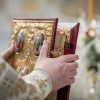On Holy Friday, we offer three services. The first is the Royal Hours of Holy Friday, which continues the themes of last night, reflecting on the horror and injustice of Christ’s Crucifixion.
When you were led to the Cross, O Lord, you cried out thus: “For which of my works do you want to crucify me, O Judeans? For healing your paralytics? For raising your dead as from sleep? I healed the woman with an issue of blood, and showed mercy to the Canaanite woman. For which act do you wish to slay me, O Judeans?” But you shall behold him, the Christ whom you pierce, O law-transgressors.
However, the next two services today are the Vespers and Matins for Holy Saturday, the day of Christ’s rest in the tomb. Here the themes shift dramatically. Christ has died on the Cross, and the cosmic consequences of this act of God’s love begin to be contemplated. In Vespers, Christ is taken down from the Cross and laid in the tomb.
When you, the Redeemer of all, were placed ion a new Tomb for us all, Hades, the respecter of none, cowered when he saw you. The bars were broken, the gates were shattered, the graves were opened, and the dead arose. Then Adam, gratefully rejoicing, cried out to you: “Glory to your condescension, O Merciful God.”
When you, O Christ, of your own will, submitted bodily to be closed in the tomb, being by nature of the Godhead, remaining indescribable and limitless, you closed down the chambers of death, and emptied the palaces of Hades. Then you rendered this Sabbath worthy of blessing and glory, and of your own splendour.
We learn in these hymns that death has changed. Death is no longer an entrance into Hades, the gloomy place holding with bars and chains all who have died, holding them away in some sense from the presence of God. Death is now a Sabbath rest for our bodies grown old in sin and an entrance into the presence of Christ who has “loosed the chains and burst the bars of Hades”.
This is a profound Mystery, and many—perhaps to our hurt—have tried to reduce this Mystery to a mechanism, so as to explain how it works, as if the Redemption of all creation were a watch mechanism that could be taken apart to be analyzed, or a legal brief to be logically understood. God is not scrutinized by his creatures, and the only logic to be understood is the logic of love. God’s Salvation and Redemption for us are to be known and experienced as an infant knows and experiences her mother, not as a mathematician knows a formula or as a mechanic knows a machine. Therefore the Church uses many metaphors and diverse images, largely drawn from the Old Testament, to lead us to an intimate, personal knowledge of God and to help us to apprehend the wonder and the goodness of God’s love for us.
Foreseeing your divine self-emptying on the Cross, Habakkuk cried out in amazement: “You cut off the power of the mighty, O Good One, speaking to those in Hades, as the Almighty.”
Glory to you, our God, glory to you.
You have sanctified the seventh day, which you blessed before you rested from your labours; for you create everything, and you renew them, observing the Sabbath and restoring yourself.
Glory to the Father and to the Son and to the Holy Spirit.
When your soul was separated from the body, the bonds of both Hades and Death were shattered with greater strength by your might, O Word of God.
Both now and ever and unto ages of ages. Amen.
Hades in encountering you, O Word, was embittered, beholding a mortal deified; covered with bruises, yet all powerful. Wherefore, it shrank back at the awesome sight.
The Holy Friday services end with the chanting of the dirges at Christ’s tomb. While we have reflected on the cosmic dimensions of Christ’s death on the Cross, Christ’s body still rests in the tomb. And so the evening ends with burial hymns chanted at Christ’s tomb and with the Gospel reading reminding us that the tomb has been sealed and a guard set. We enter with Christ into the stillness and quiet of the tomb, the Sabbath rest, to await the Resurrection.
















